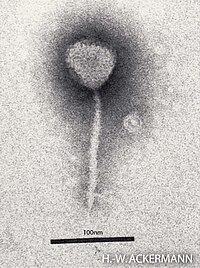
Photo from wikipedia
AIMS LexA protein is a transcriptional repressor which regulates the expression of more than 60 genes belonging to the SOS global regulatory network activated by damages to bacterial DNA. Considering… Click to show full abstract
AIMS LexA protein is a transcriptional repressor which regulates the expression of more than 60 genes belonging to the SOS global regulatory network activated by damages to bacterial DNA. Considering its role in bacteria, LexA represents a key target to counteract bacterial resistance: the possibility to modulate SOS response through the inhibition of LexA autoproteolysis may lead to reduced drug susceptibility and acquisition of resistance in bacteria. In our study we investigated boron-containing compounds as potential inhibitors of LexA self-cleavage. MAIN METHODS The inhibition of LexA self-cleavage was evaluated by following the variation of the first-order rate constant by LC-MS at several concentrations of inhibitors. In silico analysis was applied to predict the binding orientations assumed by the inhibitors in the protein active site, upon covalent binding to the catalytic Ser-119. Bacterial filamentation assay was used to confirm the ability of (3-aminophenyl)boronic acid to interfere with SOS induced activation. KEY FINDINGS Boron-containing compounds act as inhibitors of LexA self-cleavage, as also confirmed by molecular modelling where the compounds interact with the catalytic Ser-119, via the formation of an acyl-enzyme intermediate. A new equation for the description of the inhibition potency in an autoproteolytic enzyme is also disclosed. Bacterial filamentation assays strongly support the interference of our compounds with the SOS response activation through inhibition of septum formation. SIGNIFICANCE The obtained results demonstrated that phenylboronic compounds could be exploited in a hit-to-lead optimization process toward effective LexA self-cleavage inhibitors. They would sustain the rehabilitation in therapy of several dismissed antibiotics.
Journal Title: Life sciences
Year Published: 2019
Link to full text (if available)
Share on Social Media: Sign Up to like & get
recommendations!